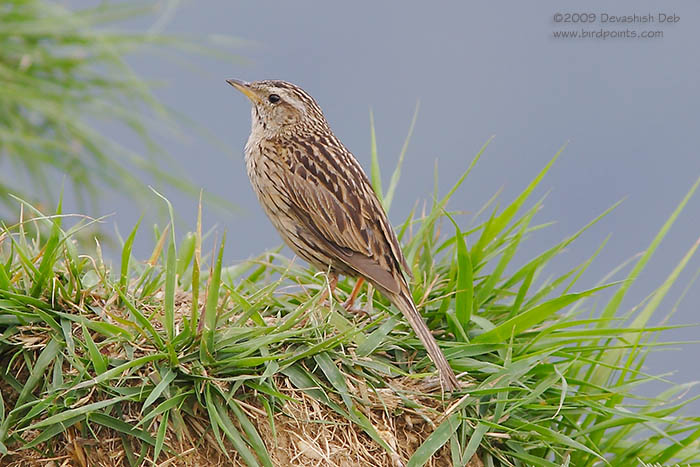|
|
| Upland
Pipit |
Anthus
sylvanus |
26
Aug 2009 |
| Full
Species (monotypic); i.e. no subspecies/races Anthus sylvanus; BH Hodgson, PZS XIII, p. 33 (1845) |
Pls use the mousewheel
to zoom in/out (Max 2X) |

|
| Upland Pipit, Anthus
sylvanus at Kakdagad, near Kedarnath, Uttarakhand, India on 7 Jul 2009.
|
Historical
Original citation: H. sylvana.-Above clear brown, picked out marginally with clear rufous, as in the Larks; below rufescent, with narrowing central stripes; chin immaculate; a dark mustache; superciliary line pale; tail-feathers internally and laterally albescent; upper coverts prolonged and pointed, as in the Larks; bill sordid fleshy or horn; legs clear, carneous; iris brown; sexes alike. Length, 7 1/2 inches; bill to gape 11/16; tail, 2 7/8; wing, 3; tarse, 1 1/16; central toe and nail, 15/16; hind, 3/4. Remark.-This singular bird has been thus particularly described because of the difficulty of sparing details by anything like an assured allocation of it. It seems to be an analogous form to Pratincola, and to belong to the Alaudinae near Brachonyx. Its tail in form reminds one of Dolichonyx. 853. Oreocorys sylvanus. The Upland Pipit. Heterura sylvana, Hodgs., Blyth, J. A. S. B. xiv. p.556 (1845); id. P. Z. S. 1845, p. 33; Blyth, Cat. p. 134; Jerd. B.I. ii, p. 239; Ball, S. F. iii, p. 207: Brooks, S. F. iii, p. 252; Hume, N&E. p. 387; id. Cat. no. 606; Scully, S. F. viii, p. 318. Oreocorys sylvanus (Hodgs.), Sharpe, Cat. B. M. x, p. 622; Oats in Hume's N.&E. 2nd ed. ii, p. 217. Coloration. The whole upper plumage, wings, and tail blackish brown, each feather margined with rich rufous buff, the terminal two thirds of the outermost tail-feather diagonally white, the penultimate feather with about an inch of white at the tip, the next feather with a narrow white tip, the next tipped very faintly at the extreme tip; an indistinct pale fulvous supercilium; sides of the head pale fulvous streaked with blackish; chin and throat white, bounded on either side by a narrow black moustachial streak; fore neck, breast, sides of the body, vent, and under tailcoverts buff streaked with black, the streaks on the breast more or less triangular, those on the other parts narrow and long; abdomen unspotted pale fulvous. In the summer the rufous margins on the upper plumage and the triangular marks on the breast become much worn away. Upper mandible blackish brown; lower mandible, legs, and feet fleshy, tip of lower mandible and claws shaded dusky; iris dark brown (Hume). Length about 7; tail 3; wing 3.2; tarsus 0.95; bill from gape 0.8; hind claw 0.35. Habits, & c. Breeds on the Himalayas from 4000 to 8000 feet about May and June, making a shallow open nest of grass on the ground under a tuft of grass or a stone, and laying four or five eggs, which are whitish marked with red and purple, and measure about 0.9 bv 0.68. |
About/Terms of use etc. at the home page
Copyright © 2006-2009 birdpoints. All rights reserved.